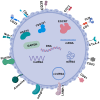Treg Cell Therapeutic Strategies for Breast Cancer: Holistic to Local Aspects
- PMID: 39329710
- PMCID: PMC11429654
- DOI: 10.3390/cells13181526
Treg Cell Therapeutic Strategies for Breast Cancer: Holistic to Local Aspects
Abstract
Regulatory T cells (Tregs) play a key role in maintaining immune homeostasis and preventing autoimmunity through their immunosuppressive function. There have been numerous reports confirming that high levels of Tregs in the tumor microenvironment (TME) are associated with a poor prognosis, highlighting their role in promoting an immunosuppressive environment. In breast cancer (BC), Tregs interact with cancer cells, ultimately leading to the suppression of immune surveillance and promoting tumor progression. This review discusses the dual role of Tregs in breast cancer, and explores the controversies and therapeutic potential associated with targeting these cells. Researchers are investigating various strategies to deplete or inhibit Tregs, such as immune checkpoint inhibitors, cytokine antagonists, and metabolic inhibition. However, the heterogeneity of Tregs and the variable precision of treatments pose significant challenges. Understanding the functional diversity of Tregs and the latest advances in targeted therapies is critical for the development of effective therapies. This review highlights the latest approaches to Tregs for BC treatment that both attenuate Treg-mediated immunosuppression in tumors and maintain immune tolerance, and advocates precise combination therapy strategies to optimize breast cancer outcomes.
Keywords: breast cancer; regulatory T cells; treatment.
Conflict of interest statement
The authors declare no conflicts of interest.
Figures






Similar articles
-
Mechanisms of regulatory T cell infiltration in tumors: implications for innovative immune precision therapies.J Immunother Cancer. 2021 Jul;9(7):e002591. doi: 10.1136/jitc-2021-002591. J Immunother Cancer. 2021. PMID: 34330764 Free PMC article. Review.
-
FoxP3+ T regulatory cells in cancer: Prognostic biomarkers and therapeutic targets.Cancer Lett. 2020 Oct 10;490:174-185. doi: 10.1016/j.canlet.2020.07.022. Epub 2020 Jul 25. Cancer Lett. 2020. PMID: 32721551 Review.
-
Expression of costimulatory and inhibitory receptors in FoxP3+ regulatory T cells within the tumor microenvironment: Implications for combination immunotherapy approaches.Adv Cancer Res. 2019;144:193-261. doi: 10.1016/bs.acr.2019.05.001. Epub 2019 Jun 6. Adv Cancer Res. 2019. PMID: 31349899 Review.
-
Regulatory T lymphocyte infiltration in metastatic breast cancer-an independent prognostic factor that changes with tumor progression.Breast Cancer Res. 2021 Feb 18;23(1):27. doi: 10.1186/s13058-021-01403-0. Breast Cancer Res. 2021. PMID: 33602289 Free PMC article.
-
Treg Fragility: A Prerequisite for Effective Antitumor Immunity?Cancer Immunol Res. 2018 Aug;6(8):882-887. doi: 10.1158/2326-6066.CIR-18-0066. Cancer Immunol Res. 2018. PMID: 30068755 Free PMC article. Review.
References
-
- Fisher B., Anderson S., Bryant J., Margolese R.G., Deutsch M., Fisher E.R., Jeong J.H., Wolmark N. Twenty-year follow-up of a randomized trial comparing total mastectomy, lumpectomy, and lumpectomy plus irradiation for the treatment of invasive breast cancer. N. Engl. J. Med. 2002;347:1233–1241. doi: 10.1056/NEJMoa022152. - DOI - PubMed
Publication types
MeSH terms
LinkOut - more resources
Full Text Sources
Medical

